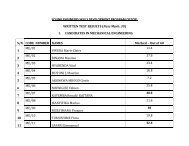lois et reglements police de roulage avec amendements
lois et reglements police de roulage avec amendements
lois et reglements police de roulage avec amendements
Create successful ePaper yourself
Turn your PDF publications into a flip-book with our unique Google optimized e-Paper software.
ways entering the roundabout ;<br />
3° In the case of overtaking on the right a driver who has shown his intention to turn on the left<br />
according to Article 21,1, second paragraph of this Decree;<br />
c) On roadways having a maximum three traffic lanes, when the driver to overtake overtakes<br />
himself a two¬wheel vehicle;<br />
d) Near a bridge, with a narrow roadway;<br />
e) Near parts of dangerous roads or mentioned as such;<br />
f) Near a passage for pe<strong>de</strong>strians.<br />
Section 7. One-wav traffic<br />
Article 23:<br />
In or<strong>de</strong>r to ensure traffic security, the Prefect may <strong>de</strong>ci<strong>de</strong> to impose a one-way traffic on the<br />
public ways that he d<strong>et</strong>ermines, in the limits of his jurisdiction.<br />
When one-way traffic must affect a Sectionof the public way str<strong>et</strong>ching out over several<br />
prefectures, <strong>de</strong>cision is taken by means of a Decree, by the Minister having Public Works in his<br />
realm.<br />
Article 24:<br />
The one-way traffic can be permanent or limited to certain hours only.<br />
When the traffic can not be suitably diverted by another way, the one-way traffic can be<br />
imposed alternately in one direction and the other.<br />
Section 8. Change of Direction<br />
Article 25:<br />
1. Every driver who wants either to turn to the right from the roadway or to turn to the left from<br />
the roadway or to stop his vehicle on the left si<strong>de</strong> of the roadway, must beforehand show his<br />
intention according to provisions of Article 44 of this Decree and:<br />
a) When to the right, keep close to the right bor<strong>de</strong>r of the road as far as possible and perform his<br />
manoeuvre in a space as restricted as possible and at mo<strong>de</strong>rate speed. He can however move to<br />
the left when the layout of the areas or the vehicle size or the load size do not permit to keep<br />
close to the right bor<strong>de</strong>r of the roadway but on condition of ensuring beforehand that none of<br />
the drivers, following him has started an overtaking and of not putting in danger drivers who<br />
move normally on the public roadway he is going to leave and on the one he is going to move<br />
onto;<br />
b) When to the left, keep on the left and close as far as possible to the end of the road, without<br />
being astri<strong>de</strong> however, or to left si<strong>de</strong> of the traffic band s<strong>et</strong> for this effect, in the case of a<br />
roadway where the traffic is runs in both directions or else to the left bor<strong>de</strong>r of the roadway, in<br />
the case of a one-way traffic, and perform his manoeuvre at mo<strong>de</strong>rate speed and , when he<br />
wants to move to another way where the traffic runs in two directions so as to reach that way by<br />
the right si<strong>de</strong>.<br />
2. When the traffic runs in parallel lines, a driver can only turn on the right when he is in the<br />
right, and on the left when he is in the file.<br />
3. During his manoeuvre of changing direction, every driver must manoeuvre slowly and l<strong>et</strong><br />
pass:




